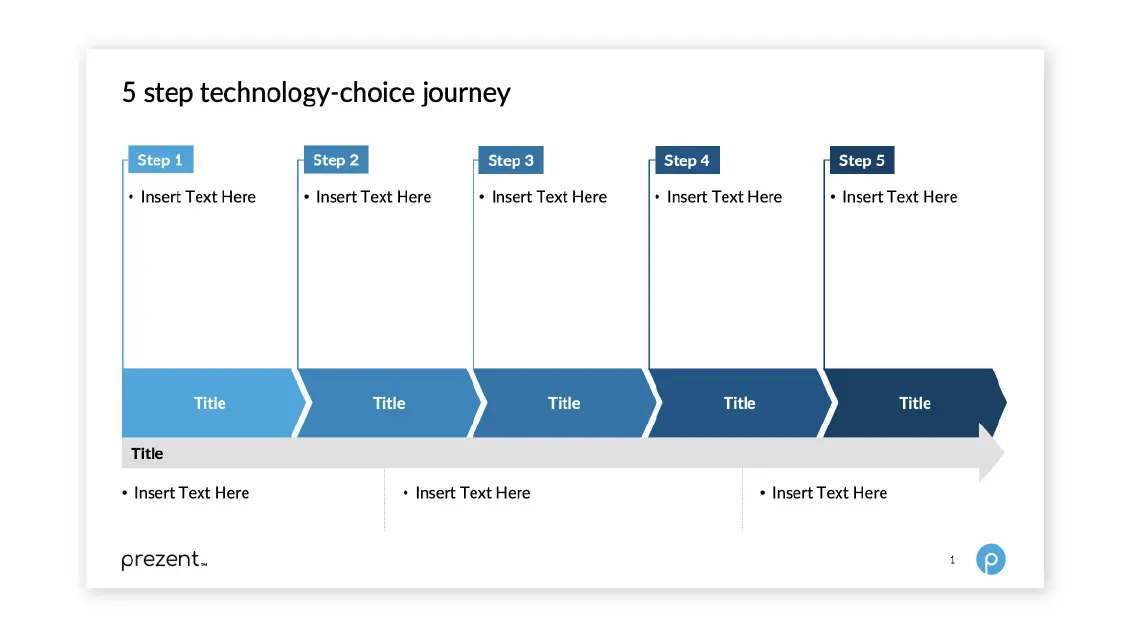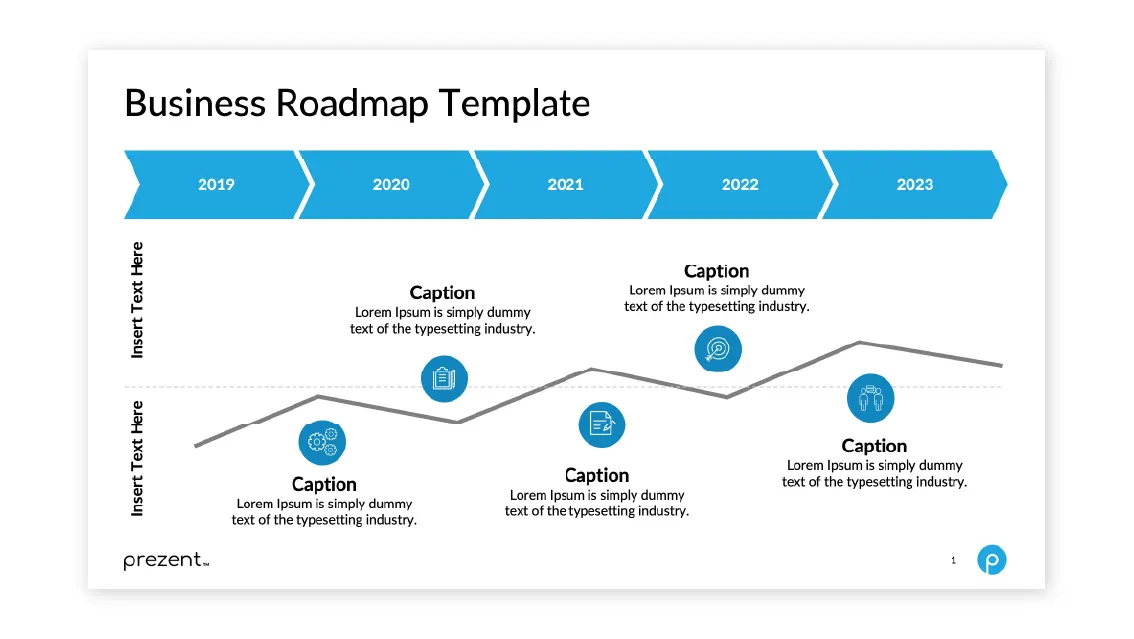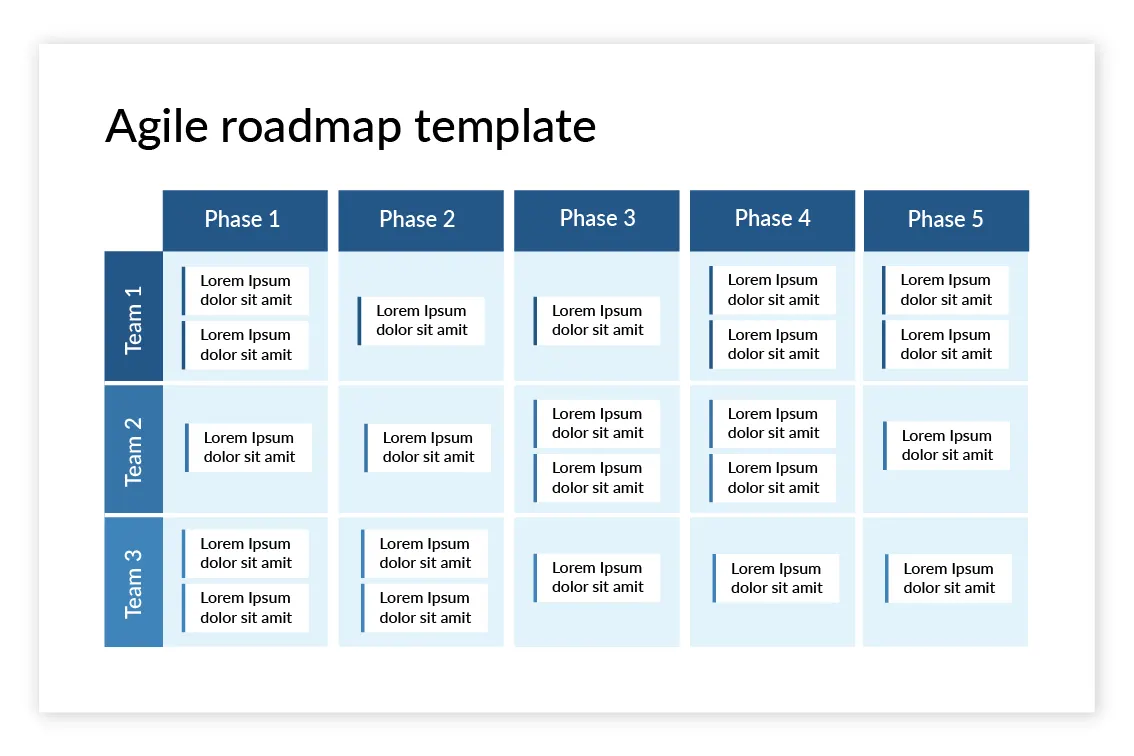How to present a roadmap? Effective roadmap presentation and creation guide (with templates)

So, you've got a brilliant vision and a strategic plan to match, but how do you convey it all without losing your audience in the details? With a roadmap—a strategic tool that can transform your grand ideas into a clear, actionable plan. This guide will not only show you how to create a compelling roadmap but also how to present it with finesse, ensuring your team is aligned, and your goals are within reach.
What is a roadmap, and why do you need one?
Imagine navigating a cross-country road trip without a map. You might get there eventually, but you’ll likely take a few wrong turns along the way. In the business world, a roadmap serves a similar purpose. It’s not about plotting every detail, but about setting a clear direction and identifying key milestones to ensure you reach your destination efficiently.
A business roadmap is a strategic document that outlines the key objectives and steps necessary to achieve a particular goal. Unlike traditional, static plans, roadmaps are dynamic and flexible, adapting to new information and changing circumstances. They provide a high-level view of the project, emphasizing major goals, timelines, and critical milestones.
To illustrate the importance of a roadmap, consider these words:
"Plans are worthless, but planning is everything." - Dwight D. Eisenhower
This highlights the value of the roadmap process itself—constantly revising and updating the roadmap based on new insights keeps the project aligned with its goals and responsive to change.
The benefits of a well-constructed roadmap are multifaceted:
- Guiding vision: It articulates a clear vision, setting out the primary goals and objectives that guide the project.
- Stakeholder communication: It keeps everyone from team members to investors informed about key milestones and progress, ensuring transparency and alignment.
- Strategic alignment: It connects short-term actions with long-term objectives, ensuring that every step taken today contributes to future success.
However, a roadmap is much more than a mere project tracker or a checklist. It’s a strategic tool that helps prioritize tasks, manage resources effectively, and make informed decisions. For instance, in software development, a product roadmap can help prioritize feature releases based on customer feedback and market demands, ensuring the development team focuses on what truly matters.
What should you include in a roadmap include?
Creating a roadmap is like charting a course for a grand adventure. To ensure you don’t lose your way, your roadmap needs to include several essential elements:
- Strategic alignment - Every initiative on your roadmap should have a clear reason for being there. It’s important to explain why and how each initiative was conceived and how it aligns with your overall business or product strategy.
- Detailed schedule - Goals without timelines are just dreams. Your roadmap should have clearly defined due dates for each deliverable, along with contingency plans in case things don’t go as expected. This schedule keeps the project on track and provides a sense of urgency and direction.
- Necessary resources - Identify all the resources you’ll need to achieve your goals. This includes both the human capital—your team members and their skills—and the physical and technical resources required to complete the tasks. Knowing what you need in advance helps in planning and prevents resource shortages from derailing your project.
- Visual clarity - A roadmap should be visually engaging and easy to understand at a glance. Use charts, graphs, and visual aids to highlight key points and make the information digestible. Avoid overcrowding your roadmap with too much text; instead, let visuals do the heavy lifting.
- Real-life context - Let’s say your company is launching a new marketing campaign. Your roadmap might include strategic goals like "Increase Brand Awareness" and "Boost Customer Engagement." The timeline would outline key milestones such as "Campaign Launch" and "Mid-Campaign Review," with specific dates attached.
By incorporating these elements, you create a roadmap that’s not only functional but also inspiring and easy to follow. It becomes a living document that guides your team, adapts to new information, and keeps everyone aligned with the ultimate goal.
"If you fail to plan, you are planning to fail." - Benjamin Franklin
Your roadmap is your plan, ensuring you navigate the journey to success with confidence and clarity.

Types of roadmaps
Roadmap planning is a flexible and adaptable technique used across various industries and functions. Here are some common types of roadmaps, along with examples.
Product roadmap
A product roadmap lays out the long-term vision, goals, and priorities for a product's development. It serves as a strategic tool to unite the organization around both immediate and future objectives, detailing how teams and individuals will achieve these goals. The roadmap should be closely linked to your company's product development strategy, competitive landscape, and customer feedback.
For example, let's take a look at this video presentation by Airbnb showcasing their product roadmap.

Technology roadmap
A technology roadmap is a strategic document or diagram that outlines a company's plan for adopting, investing in, and upgrading technologies. It assists organizational leaders in determining the timing, selection, and rationale behind integrating new technologies, helping to avoid costly errors. Additionally, a technology roadmap is used to identify when existing technologies become outdated and need replacement.

Business roadmap
Business roadmaps are essential tools that enhance a startup's strategy by providing detailed guidance and context that a standard business plan might lack. They lay out specific tasks, timelines, and assign responsibilities, ensuring that everyone knows what needs to be done and when. By defining roles and responsibilities clearly, a business roadmap ensures that all team members are aligned and working towards the same objectives, integrating various functions seamlessly.

Project roadmap
Project roadmaps offer a strategic overview of key project elements, including goals, milestones, resources, deliverables, and an anticipated timeline. They serve as essential tools for project managers, helping to communicate the project's status and strategic objectives to stakeholders. Just as a product roadmap outlines the rationale behind product development, a project roadmap articulates the strategic reasons for undertaking a project.

Agile roadmap
An agile roadmap serves as a dynamic action plan designed to achieve the product vision, inform consumers about forthcoming releases, and highlight the significance of each epic and feature within the overall product strategy. It helps teams visualize the cross-functional efforts needed to develop and market a product or enhancement. The level of detail in an agile roadmap can vary: it can present broad product goals and activities or focus on immediate tasks, depending on the project’s needs and the amount of information you wish to include.

What are the main elements of roadmapping presentations?
To build a strong and impactful roadmap, it's essential to incorporate these key components:
- Vision: Define the overarching goal or vision the roadmap aims to achieve.
- Strategy: Outline the approach or plan for reaching the vision, highlighting key initiatives and priorities.
- Expected outcomes: Specify the anticipated results or outcomes from implementing the roadmap.
- Timeline: Create a visual timeline that illustrates key milestones and deadlines.
- Metrics: Identify key performance indicators (KPIs) and metrics to measure progress and success.
- Stakeholder: List the key stakeholders involved in the roadmap, detailing their roles and responsibilities.
The elements of your roadmap planning template can vary, particularly if it's tailored for a specific business process or niche area. For instance, technology and software roadmaps often feature additional components related to development statuses, risk management, release schedules, and more.
6 steps to create a fantastic roadmap presentation
Creating a roadmap involves thoughtful preparation. First, ensure you have a well-defined project vision and an execution strategy. Have you gathered sufficient market and customer data to validate your assumptions?
When you're ready to design a roadmap for a presentation, start by ensuring you understand your market trajectory, existing business constraints, desired outcomes, and overall company objectives. Once these elements are clear, you can proceed with the following step-by-step guide.
1. Plan with purpose
Start by clearly defining the needs your roadmap will address rather than just listing the steps. It should guide those responsible for execution by setting a clear direction. Formalize your goals first.
Forrester suggests
"Your product roadmap should focus on customer needs, the impact of addressing those needs, and the planned actions to meet them—not just technical details."
If you need more customer insights or doubt their accuracy, you should:
- Conduct new market research
- Gather and analyze customer feedback (VOC data)
- Consult with team members and business stakeholders
Leverage these insights to establish SMART goals—specific, measurable, attainable, relevant, and time-bound objectives.
2. Prioritize your objectives
Once you have your goals, the next step is to prioritize and organize them on a timeline. Due to the fast-changing market and evolving corporate goals, most roadmaps span a quarter or a year.
Sort your goals into:
- Short-term (weekly/monthly)
- Long-term (quarterly/annual)
Visually arrange these goals on a roadmap. If it looks cluttered, group similar goals into themes and prioritize them based on strategic importance.
"When everything is a priority, nothing is a priority." - Karen Martin, an Author
Focus on steps that align closely with your project vision and prioritize those that deliver the most value to customers.
3. Choose the right template
Different projects call for different roadmap templates. Experiment with various formats, such as:
- Gantt charts are ideal for detailed planning. They show all activities, requirements, and timelines in one view, simplifying progress tracking.
- Timeline roadmaps: Best for high-level overviews, informing stakeholders about key activities and timelines.
- Metrics-based roadmaps: Suitable for technology teams needing granular details. Tools like Confluence can be useful for detailed sprints and development backlogs.
Tailor your roadmap’s format, content, and presentation to fit your audience. Development teams might appreciate detailed technical terms, while business leaders will focus more on timelines and outcomes.
4. Define success metrics
Incorporate milestones and checkpoints into your roadmap to track progress. Clearly define what success looks like and how it will be measured. Consider metrics such as:
- Sales and marketing: Customer acquisition costs (CAC), average revenue per user, customer lifetime value (CLV), and customer satisfaction score (CSAT).
- Technology: Number of features delivered, team velocity, work-in-progress, sprint completion rates.
Using the right metrics ensures you can assess progress effectively and make necessary adjustments.
5. Stay adaptable
Roadmaps should be flexible to accommodate changes in market conditions and organizational priorities. Be open to revising your roadmap as new information becomes available. Update related tasks and timelines to ensure continued alignment with your project vision.
6. Communicate and review regularly
Review and communicate updates on your roadmap regularly with your team and stakeholders. This ensures everyone stays informed about changes and maintains alignment with the project’s goals. Ongoing communication fosters transparency and keeps the project on course.
Choosing the correct roadmap presentation tool
Teams, managers, and organizations need to understand the specific requirements of each project when selecting a roadmap tool. Since each tool offers unique features, here are several options to help you create a professional-quality roadmap quickly:
- Microsoft project is ideal for those who need a straightforward Gantt Chart without elaborate graphics. It is a classic tool for efficiently presenting timelines and tasks. However, it lacks the flexibility of PowerPoint in terms of working with shapes and various formats.
- Microsoft powerpoint: A go-to option for many, PowerPoint offers built-in templates that simplify the creation of various types of roadmaps. Additionally, Microsoft 365 subscribers can access a wider range of templates from the online store, enhancing their presentation capabilities.
- Google slides: This free, web-based alternative to PowerPoint is perfect for those who prefer working in the cloud or have budget constraints. It allows you to import and work with PowerPoint templates and files, making them function seamlessly within Google Slides.
- Prezent: Prezent offers several innovative features that significantly enhance the creation and presentation of roadmap plans. Here’s how each feature makes presentations more effective and engaging:
- Slide library: With access to a vast collection of slide templates, you can easily find and utilize the slides that best fit each segment of your roadmap presentation. This feature saves time and guarantees a high design quality and consistency standard, making your presentation look professional and visually appealing.
- Auto generator: Pressed for time? The Auto Generator is your solution. Input your data, and the tool will quickly produce a draft of your presentation. This feature is perfect for creating a strong starting point, especially when you’re on a tight schedule but still need to deliver a high-quality presentation.
- Redesign: Have old slides that need an update? The Redesign feature revitalizes them by applying new, modern templates. This allows you to keep your presentations looking fresh and current without starting from scratch, saving time and ensuring consistency across your presentations.
- Best Practice Library: Offering access to over 10,000 expert-curated slides and presentations across various roles and functions, this library democratizes premium content once exclusive to top consulting firms.
Presenting a roadmap with confidence
Communicating clearly with stakeholders and ensuring everyone understands the objectives and direction is crucial for aligning everyone during your product roadmap presentations.
1. Emphasize the "Why"
Whether you're presenting a traditional feature roadmap or a set of objectives and key results (OKRs), explaining the rationale behind your initiatives is essential. Are you aiming to tap into a new market opportunity or improve user satisfaction for a specific segment? Clarifying these motivations helps your team understand the importance of their tasks.
When your team is responsible for developing solutions and defining their success, they must understand why these initiatives are significant for users and the business. As you present, highlight the context behind each item on the roadmap, tailoring your message to your audience. Technical teams will need data-driven evidence of demand, while executives will look for alignment with business priorities.
Address the needs of different stakeholders, which you may have identified in prior meetings or interviews. Clearly explain the trade-offs made during planning so stakeholders can appreciate the considerations involved.
💡 Pro Tip: Use data to support your points, but also weave in user stories to illustrate the value of your ideas and discuss alternatives you considered but decided against.
2. Tell a compelling story
Effective storytelling can win over top executives, engage disengaged team members, and persuade skeptics. Use your roadmap to tell the story of your product's evolution, keeping your audience captivated and supportive of your plans. Highlight customer feedback that led to new features, decisions that align with the product vision, and any tough prioritization choices you faced.
Use straightforward language and avoid jargon to ensure clarity, especially when addressing a diverse group of stakeholders. This approach helps communicate your product roadmap effectively.
3. Enhance engagement with visual aids
Visuals are key to helping stakeholders see how different elements of your product strategy fit together. Invest in a well-designed roadmap presentation template. Whether using dedicated road mapping tools, PowerPoint, infographics, Gantt charts, or Excel, visual elements help stakeholders grasp the overall strategy and track the development and release of product iterations.
Here are some tips:
- Customize for different audiences: Present different versions of your roadmap tailored to specific audiences. Filter your content by epics or outcomes and only show what’s relevant to the team or department you’re addressing.
- Use color effectively: Use color to differentiate your roadmap's themes, objectives, or categories. Include a legend to explain what each color represents.
- Keep it focused: Avoid overwhelming your audience with excessive details. Your visual roadmap should highlight the most pertinent insights and graphics. When in doubt, simplify.
By following these steps, you can ensure that your product roadmap presentations are clear, engaging, and aligned with your stakeholders' needs, paving the way for successful implementation and buy-in.
Conclusion
In summary, a roadmap serves as a strategic guide rather than a detailed execution plan. It outlines your vision through key steps and milestones, providing direction even if all specifics aren't finalized. It's important to share your initial plans and remain flexible, updating your roadmap as new information becomes available.
To enhance your presentations, take advantage of presentation templates and slides by Prezent. These tools can streamline the creation process, ensuring your presentations are professional and impactful.
Join countless others in effortlessly enhancing your presentations and significantly impacting your audience using these powerful tools and features. Book a free trial or schedule a demo to experience the product firsthand.

.avif)










